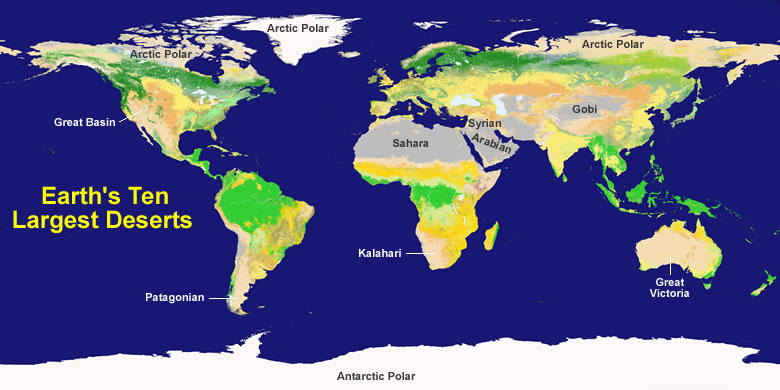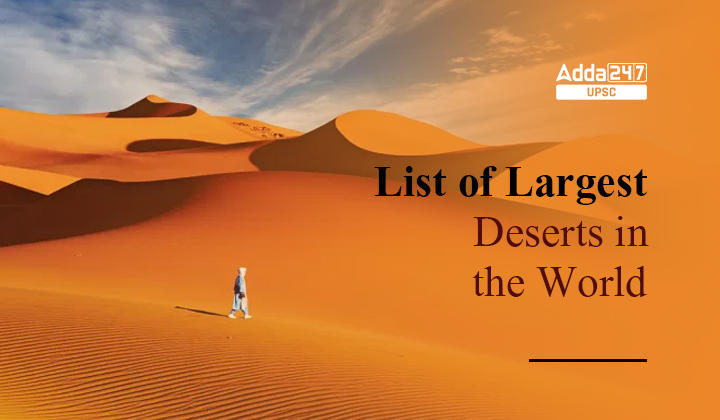Table of Contents
How are Large Deserts in the World important for UPSC CSE?
- Desert Biome is part of the UPSC GS 1 syllabus. So, understanding the concept and remembering the names of the Large Deserts in the World is one of the most essential parts of UPSC Civil Services Examination preparation.
- Desertification and Soil Degradation is one of the biggest threat the world is facing today. So, a thorough understanding of Large Deserts in the World is important from UPSC’s Current Affairs perspective also.
What is a Desert?
- A desert is a landscape or region that receives very little precipitation – less than 250 mm per year (about ten inches). Approximately 1/3 of Earth’s land surface is a desert.
- There are four different types of deserts based upon their geographic situation: 1) polar deserts, 2) subtropical deserts, 3) cold winter deserts, and 4) cool coastal deserts. Deserts occur on all of Earth’s continents.

List of Earth’s Major Deserts
| Name | Type | Location | Area (km2) |
| Antarctica Desert | Polar ice and tundra | Antarctica | 14,200,000 |
| Arctic Desert | Polar ice and tundra | Eastern Europe, Northern America, Northern Asia, Northern Europe | 13,900,000 |
| Sahara Desert | Subtropical | Eastern Africa, Middle Africa, Northern Africa, Western Africa | 9,200,000 |
| Great Australian | Subtropical | Australia | 2,700,000 |
| Arabian Desert | Subtropical | Western Asia | 2,330,000 |
| Gobi Desert | Cold Winter | Eastern Asia | 1,295,000 |
| Kalahari Desert | Subtropical | Southern Africa | 900,000 |
| Patagonian Desert | Cold Winter | South America | 673,000 |
| Syrian Desert | Subtropical | Western Asia | 500,000 |
| Great Basin | Cold Winter | Northern American | 492,098 |
| Chihuahuan Desert | Subtropical | Northern American | 453,248 |
| Karakum Desert | Cold Winter | Central Asia | 350,000 |
| Colorado Victoria | Cold Winter | Northern Asia | 337,000 |
| Sonoran Desert | Subtropical | Central America Northern America | 310,000 |
| Kyzylkum Desert | Cold Winter | Central Asia | 300,000 |
| Taklamakan Desert | Cold Desert | Eastern Asia | 270,000 |
| Ogaden Desert | Subtropical | Eastern Asia | 256,000 |
| Puntland desert | Subtropical | Eastern Asia | 200,000 |
| Thar Desert | Subtropical | Southern Asia | 200,000 |
| Ustyurt Plateau | Temperate | Central Asia | 200,000 |
| Guban Desert | Subtropical | Eastern Asia | 175,000 |
| Namib Desert | Cool Coastal | Middle Africa, Southern Africa | 160,000 |
| Dasht-e-Margo | Subtropical | Southern Asia | 150,000 |
| Registan Desert | Subtropical | Southern Asia | 146,000 |
| Atacama Desert | Mild Coastal | South America | 140,000 |
| Danakil Desert | Subtropical | Eastern Africa | 137,000 |
| Mojave Desert | Subtropical | Northern American | 124,000 |
| Chalbi Desert | Subtropical | Eastern Africa | 100,000 |
| Columbia Basin | Cold Winter | Northern America | 83,139 |
| Dasht-e-Kavir | Subtropical | Southern Asia | 77,000 |
Know About Thar Desert
- The name, Thar is derived from thul, the general term for the region’s sand ridges.
- It is located partly in Rajasthan state, northwestern India, and partly in Punjab and Sindh provinces, eastern Pakistan.
- The Thar Desert is an arid region that covers over 2,00,000 sq km.
- It forms a natural boundary along the border between India and Pakistan.
- The desert presents an undulating surface, with high and low sand dunes separated by sandy plains and low barren hills, or bhakars, which rise abruptly from the surrounding plains.
- The dunes are in continual motion and take on varying shapes and sizes.
- Barkhan is, a crescent-shaped sand dune produced by the action of wind predominately from one direction. One of the commonest types of dunes, it occurs in sandy deserts all over the world.
- Thar desert is bordered by the irrigated Indus River plain to the west, the Punjab Plain to the north and northeast, the Aravalli Range to the southeast, and the Rann of Kachchh to the south.
- The climate of the Thar desert is a subtropical desert climate due to persistent high pressure and subsidence at that latitude.
- The prevailing southwest monsoon winds that bring rain to much of the subcontinent in summer tend to bypass the Thar to the east.
Are Deserts always hot?
- Deserts are areas that receive very little precipitation. People often use the adjectives “hot,” “dry,” and “empty” to describe deserts, but these words do not tell the whole story.
- Although some deserts are very hot, with daytime temperatures as high as 54°C (130°F), other deserts have cold winters or are cold year-round.
- And most deserts, far from being empty and lifeless, are home to a variety of plants, animals, and other organisms.
- One thing all deserts have in common is that they are arid, or dry.
- People have adapted to life in the desert for thousands of years.
Types of Deserts
- The world’s deserts can be divided into five types—subtropical, coastal, rain shadow, interior, and polar. Deserts are divided into these types according to the causes of their dryness.
- Subtropical Deserts
- Subtropical deserts are caused by the circulation patterns of air masses. They are found along the Tropic of Cancer, between 15 and 30 degrees north of the Equator, or along the Tropic of Capricorn, between 15 and 30 degrees south of the Equator.
- Hot, moist air rises into the atmosphere near the Equator. As the air rises, it cools and drops its moisture as heavy tropical rains. The resulting cooler, drier air mass moves away from the Equator. As it approaches the tropics, the air descends and warms up again. The descending air hinders the formation of clouds, so very little rain falls on the land below.
- The world’s largest hot desert, the Sahara, is a subtropical desert in northern Africa. The Sahara Desert is almost the size of the entire continental United States. Other subtropical deserts include the Kalahari Desert in southern Africa and the Tanami Desert in northern Australia.
-
Coastal Deserts
- Cold ocean currents contribute to the formation of coastal deserts. Air blowing toward shore, chilled by contact with cold water, produces a layer of fog. This heavy fog drifts onto land. Although humidity is high, the atmospheric changes that normally cause rainfall are not present. A coastal desert may be almost totally rainless, yet damp with fog.
- The Atacama Desert, on the Pacific shores of Chile, is a coastal desert. Some areas of the Atacama are often covered by fog. But the region can go decades without rainfall. In fact, the Atacama Desert is the driest place on Earth. Some weather stations in the Atacama have never recorded a drop of rain.
-
Rain Shadow Deserts
- Rain shadow deserts exist near the leeward slopes of some mountain ranges. Leeward slopes face away from prevailing winds.
- When moisture-laden air hits a mountain range, it is forced to rise. The air then cools and forms clouds that drop moisture on the windward (wind-facing) slopes. When the air moves over the mountaintop and begins to descend the leeward slopes, there is little moisture left. The descending air warms up, making it difficult for clouds to form.
- Death Valley, in the U.S. states of California and Nevada, is a rain shadow desert. Death Valley, the lowest and driest place in North America, is in the rain shadow of the Sierra Nevada mountains.
-
Interior Deserts
- Interior deserts, which are found in the heart of continents, exist because no moisture-laden winds reach them. By the time air masses from coastal areas reach the interior, they have lost all their moisture. Interior deserts are sometimes called inland deserts.
- The Gobi Desert, in China and Mongolia, lies hundreds of kilometers from the ocean. Winds that reach the Gobi have long since lost their moisture. The Gobi is also in the rain shadow of the Himalayan mountains to the south.
-
Polar Deserts
- Parts of the Arctic and the Antarctic are classified as deserts. These polar deserts contain great quantities of water, but most of it is locked in glaciers and ice sheets year-round. So, despite the presence of millions of liters of water, there is actually little available for plants and animals.
- The largest desert in the world is also the coldest. Almost the entire continent of Antarctica is a polar desert, experiencing little precipitation. Few organisms can withstand the freezing, dry climate of Antarctica.
FAQs
Q. Which is the largest desert in the world?
Ans. Antarctica Desert
Q. Which is the largest hot desert in the world?
Ans. The largest hot desert in the world is the Sahara, which is 9 million square kilometers (3.5 million square miles). It isn’t the hottest place on Earth, though.
Q. Which are the five largest deserts in the world?
Ans. The five largest deserts in the world are Sahara, Antarctic desert, Arctic desert, Great Australian, and the Arabian desert.
Q. Which are the subtropical deserts of the world?
Ans. The subtropical deserts of the world are the Sahara Desert, Arabian desert, Kalahari Desert, Thar desert, Sonoran Desert, and Chihuahuan desert.




 TSPSC Group 1 Question Paper 2024, Downl...
TSPSC Group 1 Question Paper 2024, Downl...
 TSPSC Group 1 Answer key 2024 Out, Downl...
TSPSC Group 1 Answer key 2024 Out, Downl...
 UPSC Prelims 2024 Question Paper, Downlo...
UPSC Prelims 2024 Question Paper, Downlo...
